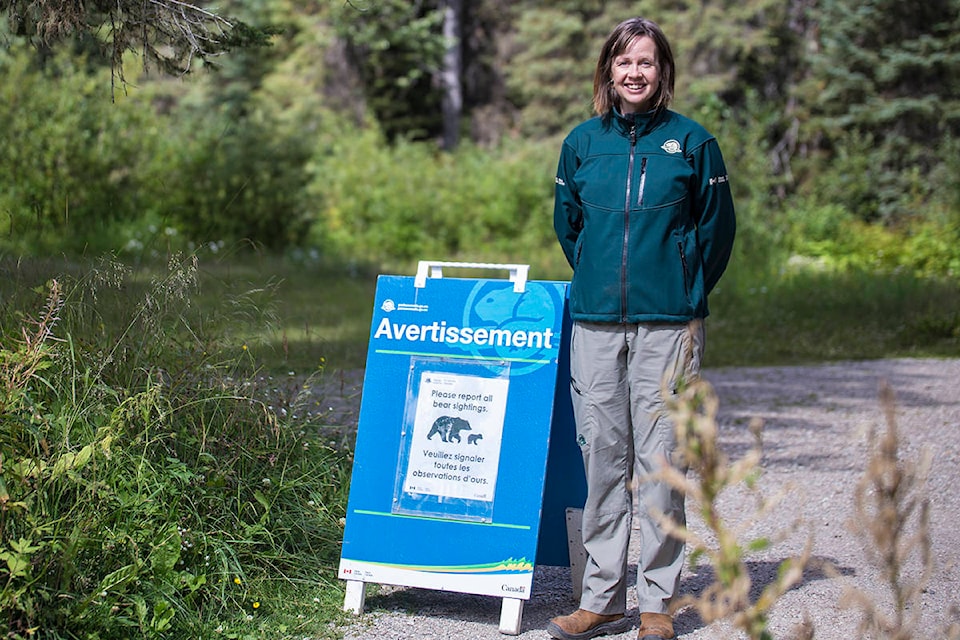It’s the time of year when grizzly bears head to their dens and sleep away the winter, and Parks Canada knows exactly where bear 49 sleeps.
But the location is top secret.
The wildlife management team put an ear tag and GPS collar on bear 49 in the summer of 2018.
“We try not to handle and immobilize animals unless we feel it is necessary,” said Brianna Burley, wildlife ecologist for Mt. Revelstoke and Glacier National Parks.
READ MORE: Grizzly bear and off-leash dog encounters have caused some trails to be closed to dogs in Mt. Revelstoke National Park
The decision to close the summit of Mt. Revelstoke National Park, trap, immobilize and tag bear 49 was approved by the park’s animal care committee.
A part of the bear’s home range, the area where he lives and feeds, is the summit area, and after the bear had an encounter with an off leash dog, parks staff decided it would be best for everyone if they could track his movements.
Now they can look up the bears location in real time, or, the collar records coordinates every two hours.
It has proved useful.
This summer, bear 49 was chased by an off leash dog, however, he turned around and chased it back to it’s owner. The owner was able to get the dog under control and the bear took off, said Shelley Bird, communications officers for the parks.
“Because we had his GPS collar data we could look somewhat real-time to see what the disturbance was on that animal,” said Burley. “It appears that right after that incident he moved 12 km away from the point of interaction with the dog.”
READ MORE: Monitoring amphibians in Mt. Revelstoke and Glacier National Park
Although it isn’t unusual for bear 49 to move 12 km in a day, this was continuous movement, at a time when he should be conserving energy, finding food and putting on fat for hibernation.
If it had been a female with a cub, Burley speculated, that incident would have been really detrimental to their survival.
Other data collected by tracking bear 49’s whereabouts has helped with people management, Bird said.
Bear 49 in Mt Revelstoke and bear 50, a female grizzly whose home range is in Glacier National Park, are the only two bears living in the parks that have been tagged by parks staff.
But there are many, many more living, or passing through the area.
Both Mt. Revelstoke and Glacier have great bear habitat, said Burley.
A big part of Burley and her team’s job, is preventing and addressing human-wildlife conflict.
“Our number one priority is safety,” she said. Of both the humans and the wildlife.
READ MORE: Mt. Revelstoke bee inventory project blooms alongside summer wildflowers
This priority permeates even the design of the campgrounds, which include food storage lockers and bear proof garbage bins, said Bird.
From there the wildlife team has a variety of tools they can use including advisories, restrictions and closures. For example, Balu Pass was closed at the end of the summer because it is an ideal feeding ground for bears and, at times, certain areas are restricted to groups of four people or dogs are banned.
“Ideally, if bear in an area that is suitable, we would love to let the bear be and manage the people,” Burley said.
In cases where the bear is in an area it shouldn’t be, such as in the middle of a campground, the wildlife conflict management team is called in to move the bear along.
Sometimes getting a large group of people together or just yelling “hey bear,” gets them on their way. Sometimes bears run when they see the Parks Canada truck, or even just the uniform, Bird said with a laugh.
Both a weary bear and a highly habituated bear might react to this low-force hazing, Burley said. The habituated bears know what is coming next and the weary bears are just that.
READ MORE: PHOTOS: Highway 1 improvements restoring fish habitat in Glacier National Park
“You want to achieve the behaviour you are after with the least amount of force,” Burley added.
If yelling doesn’t work parks staff will try louder noises, such as whistles or air horns. They also have bangers and screamer pistols.
If the bear still hasn’t moved on, staff will move on to impact projectiles. They have chalk balls, which are low impact, and if necessary they have rubber bullets and bean bags.
“Depending on the circumstances and what’s happening, we do a risk assessment and then use our tools and training appropriately,” Burley said.
In the end, managing interactions between bears and humans is a day-to-day part of having a national park in bear country.
@JDoll_Revy
jocelyn.doll@revelstokereview.com
Like us on Facebook and follow us on Twitter.
